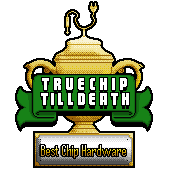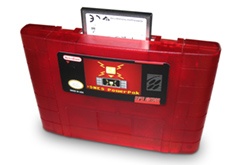- Pulsar: Two Great Bits Of News PowerPak Support http://ht.ly/2Zfv8 #
- RT @baluntweet: Another review of Memoria Textil!…. thanks! RT @AtBatedBreath: The sounds of Balún @ http://wp.me/pHlem-2c4 #
- Smash the Business Twit with piggytracker soundtrack by Simon Schäfer http://ht.ly/2ZIG4 #
- kitsch-bent — super everdrive (non-usb) snes flashcart http://ht.ly/2ZPO6 #
- 6955 scores Dyad http://ht.ly/2ZQtg #
|
|
||
|
Perhaps more so than any of our categories, the worldwide economic crises probably impacted hardware the most. There were many less hardware products, especially commercial products, but the ones that did appear have proven to have an impact on how we create and display our works in the realm of chip. Here are your 2009 nominations for Best Hardware: Ultrasatan – This is perhaps representative of most of the modern chip devices. A tool that in itself does not enable the production of chip art, but one that simplifes workflows, provides better storage and backup, and takes all the danger and frustration that comes with interfacing with old storage mediums. Ultrasatan is well designed and well liked by its users and is a great example of it’s ilk. TNS-HCF3 – Perfect for mml fanatics and nsf collectors alike, this cartridge for famicom systems enables playback of NSF sound files from an sd cart. The TNS-HFC3 adds several improvements over the TNS-HFC2 including Increased bank memory, VRC6 hardware support (without the TNS-HFE4 expansion) and SD cards up to 2GB. Arduinoboy Mini – Taking advantage of the smallest kid on the arduino block, the Mini was a marvel in compact design and performance. The few people who managed to get a hold of one can attest to the quality and portability of these little guys. One can only hope that another run of these will happen in the future. USB Gameboy Carts – Cartridge based trackers like LSDJ are only as strong as their weakest links, and numerous works of staggering genius has been lost to wonky backup software, or flaky storage products, or dodgy computer setups. The USB carts that appeared this year where a definite step forward, not only in their ease of use and reliability, but as one nominating wag put it “…(T)heir ability to create human drama”. Looking forward to further advances in this field in 2010, with universal love and understanding. SNES Powerpak – It has not kicked off the kind of widespread development that its NES forfather has quite yet, but having the ease of use for developers and artists alike should mean a bright future for this new kid on the block from Retrozone. Yea I know I’ve said I think SPC sound is kinda sucky, but this should at least be funny for some mode 7 visuals at your next chip rave. Details:
via RetroZone. The majority of the chip community are able to do what they do by standing on the shoulders of giants. These tech wizards design hardware modifications that allow integration with modern equipment, allow them to play their compositions on actual hardware, and make the arcane and some times obtuse world of technology more immediate and useful. Your nominees are: Powerpak – Retrozones little cart that could is quickly becoming the lifeblood of NES/Famicom development. With support for various mappers, and now the ability to easily play NSF music files and support various expansion chips, many artists can now record songs off real hardware that but a few months ago where merely dreams. If 2009 finds a flood of NES related output, it will surely be in no small thanks to the Powerpak.
MSSIAH – Similarly to the MGB, MSSIAH improves over existing software and makes it easier out of the box to integrate the awesome power of the SID chip with modern equipment. Tightly integrated with its software, and easily interchangeable with various models of c64 hardware, this is an elegant solution to a complicated need for getting your SID sounds into your existing work flow. Little-Scale – Perhaps more so than any hardware developer, Australia’s Little-Scale has been consistently blowing away the community with his projects for Atari, Sega, Nintendo and more. His thirst for innovation is often matched by his clean, detailed documentation process and his ability to explain things in a simple yet evocative manner belies the complexities of his achievements. Hardsid4U – If you must fake it, nothing beats using the actual chip, and no solution gives you more options to do so than the Hardsid4u. You are equally able to compose in a midi sequencer using the VST, in a windows program like Goattracker, in a traditional tracker using a Hardsid4u enabled Emulator, or simply enjoy SID files using a copy of Winamp. Along with its slightly more future proof usb interface, this is Perhaps the greatest combination of power, usability, and sound quality in its field, Hardsid4u is made with high standards and its developers provide top notch support. B00DaW reports: Loopy has yet again created a monster. Located here, people are now able to utilize Namco’s N106 8 additional freeform wave channels. N106 is indeed the holy grail of any and all expansions for the Famicom — now available for the Nintendo hardware! To explain why N106 is such a holy grail, we all know you Gameboy kiddies like to use your wave channel, right? N106 is EIGHT of them. So, suck it. (This means sampling and synthesis of any wave one desires.) Unfortunately, the only way to interface them at the moment would be to use PPMCK. It’s not all that much of a limitation since you can use FamiTracker to create your envelopes and browse Japanese sites and old 2ch logs to find many open anon-posted .mml files which show you how to create N106 waveforms — not to mention FDS FM waveforms as well. And to further put a nail in the coffin to support that “Daddy knows best” over his little boy (Gameboy), the audio out register $4011 is also known to be able to modulate 4 additional software mixed 7-bit PCM wave channels without any expansion — cited here. Fortunately and unfortunately, the NSF file format would need to be updated to allow for modulated and synthesized PCM output to play this type of audio. An example of this can be found by listening to Skate or Die 2’s intro screen on hardware versus a ripped NSF in its current format — but was hacked a while ago to include it too. The format has already been drawn-up and brought under criticism. It should work, but since there is no interface for this technology, nobody has made the format. So, that innovation is between a rock and a hard place currently. One last note… Even though one could use 4 additional 7-bit PCM channels, obviously it doesn’t come without a price. It uses a lot of resources, to put it lightly. This means if you wanted to create visuals or something else, it may not work with 4 channels, but maybe 1 or 2 additional only. As for NSF or pure sound, the sky just may be the limit. \o/ In summary, this makes the 8-bit Nintendo capable of 16 channels of audio — depending on the coding of the engine and tracking of the composer. +2 Pulse …BOW DOWN, FOOLS! Hyperbole aside, this makes the powerpak a must buy.. oh man we can! |
||


Comments